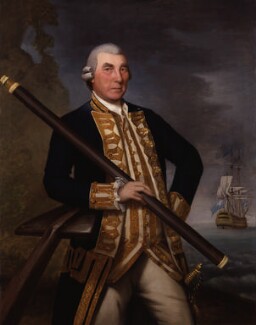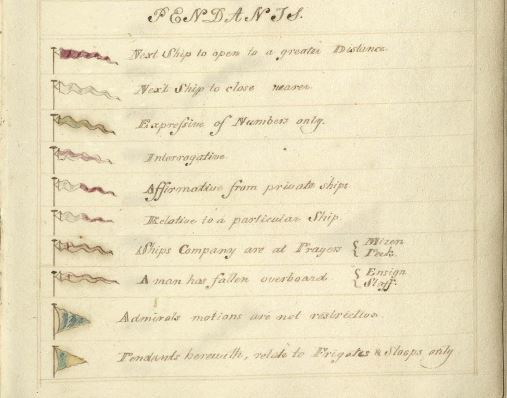The Language of the Seas: Signal Flags in the British Navy
By Sarah Donovan, Omohundro Institute Apprentice, William & Mary
Welcome back to our Georgian Goodies blog series, where we highlight interesting, timely, or just plain nifty documents from the Georgian Papers Programme!
How did flags help William IV communicate on the open seas? By 1806, William, then the Duke of Clarence, had invested in his own naval signal book. William was on the cutting edge of maritime communication as such manuals were long absent from British naval tactics.

Signal book for the British Royal Navy, GEO/ADD/4/173
Sailors have depended on signal flags to communicate across vessels since ancient Greece. Flags distinguished friendly ships from foes, but flags also became crucial in communicating tactics within a fleet as early as 429 B.C. While the ancient Greeks may have used specific signals to communicate on the high seas, the modern system of naval communication found its roots in the 14th century as overseas expeditions increased the need for communication systems.[1]
As European powers began sponsoring exploration in the 16th and 17th centuries, the French were the first to adopt formal signal instructions that included flags specifically made to communicate tactics. The British, on the other hand, were much slower in adapting a signal system and often repurposed flags that already served other purposes. [2]

Richard Kempenfelt, by Ralph Earl
oil on canvas, 1783
NPG 1641
The 18th century saw an explosive growth in maritime commerce within the British Empire. The emerging transatlantic economy required a significant naval force to maintain and challenged naval leaders to develop a way to organize and communicate between ships. The informal and unofficial British signal system was not equipped to manage such a large naval force. As late as 1779, admiral Richard Kempenfelt wrote, “we have no regular system of tactics you know…Of two fleets if one acts by a regular system of tactics when the other has none, I needn’t say where the advantage must lay.”[3] The French, who had organized a system of tactical signals in the 16th century, posed a real threat to British imperial interests and naval might.
Despite their slow start, the English did employ signal books as early as 1714. John Greenwood’s signal book was the first of the sort published in England and was not updated until some thirty years later by John Millan in 1746. However, both manuals were merely commercial ventures rather than tactical works.[4]

Signal book for the British Royal Navy, GEO/ADD/4/173
The outbreak of the American Revolution only exacerbated the communication problems that Kempenfelt and many other high-ranking naval officers had observed during the last few decades of the 18th century. In recognizing their lack of a formal naval communication system, Kempenfelt as well as Lord Howe offered their own signal systems to rectify communication problems and strengthen the might of the British Navy.[5]
As a member of the Royal Navy since 1778, William, Duke of Clarence would have experienced first-hand the limits of the informal signal system during this transitional period of naval communication. The signal book in the Georgian Papers, belonging to William published in 1806 provides evidence that William supported the formalization of a signal system as attempted by Howe and Kempenfelt during the American Revolution.[6] As king, William IV continued to support the British Navy and helped create a powerful force.
[1] William Davis Miller, “The Background and Development of Naval Signal Flags,” Proceedings of the Massachusetts Historical Society 68, (October 1944-May 1947) ,60-61.
[2] Miller, “The Background and Development of Naval Signal Flags,” 63.
[3] Julian S. Corbett, ed., Signals and Instructions, 1776-1794 with Addenda to vol. XXIX, (The Naval Records Society, 1858), 2-3.
[4] Miller, “The Background and Development of Naval Signal Flags,” 66.
[5]Lord Howe employed his signal system from 1776-1778, for further details see, Corbett, Signals and Instructions, 82-116.; Kempenfelt also offered a signal system, which he employed from 1779-1782. For details on his signal system, see Corbett, Signals and Instructions, 117-179.
